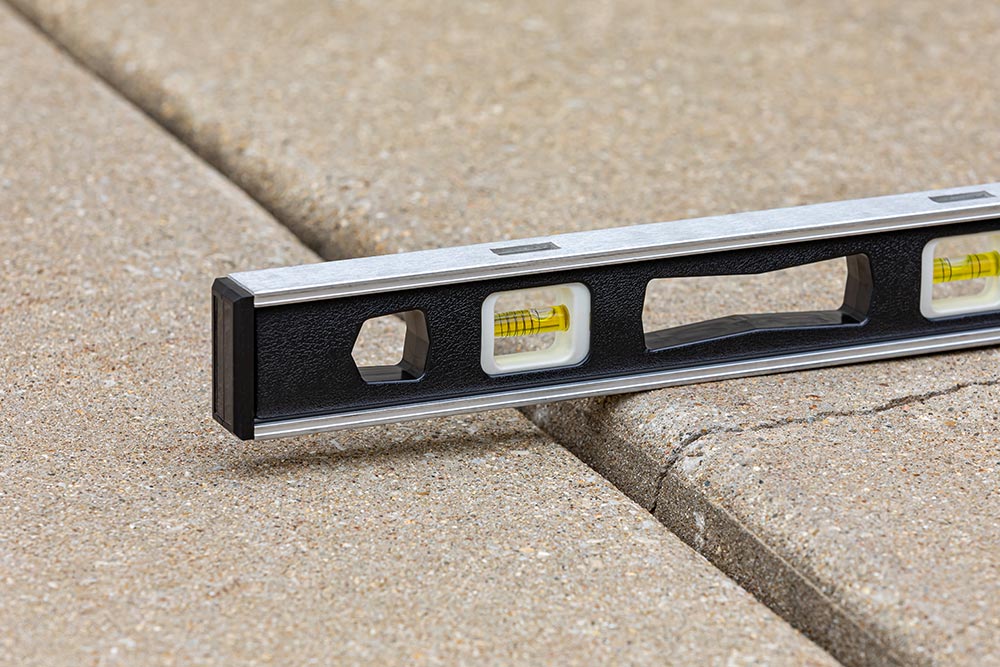Polyfoam is a polyurethane resin that can either be two-component (which expands) or single-component (which acts as a permeation grout). The two-component resin starts as two separate chemicals. Once it’s mixed, they’ll expand 15-50 times their liquid state. Single-component resin reacts with ground moisture to infiltrate and combine with the surrounding soil to create a waterproof mass that can be used to stabilize it. There’s also leak seal resin, which can be used to seal leaks in concrete structures.

Here are some common questions people ask about Polyfoam concrete lifting:
Some people have saved as much as 50-75% compared to a “tear out and replace” approach. So, it can not only be less expensive but will also require less downtime. The resin can be cured in as little as 20 minutes, so it will be ready by the time the process is completed.
For PolyFoam concrete lifting, small holes that are about the size of a dime are drilled into the slab. This allows the resin to be pumped under the concrete. Once the lifting process has been completed, they’re patched up before the area is cleaned up. Other concrete lifting methods (such as mudjacking) require the use of heavier equipment and the drilling of larger holes that are about the size of a baseball.
On average, the process of lifting concrete with Polyfoam takes about 2-3 hours to complete, and the resin will have cured by the time the process is finished.
Because it’s impervious to water, Polyfoam concrete lifting is much better than mudjacking (which is water soluble and will only last 2-4 years before it dissolves and sinks again). When it’s pumped under a concrete slab, Polyfoam has a life expectancy of 70-200 years. The only caveat is that it won’t levitate. So, you need to have strong soil that has been well compacted for it to hold up.
Weak, loose, and non-compacted soil will continue to settle until it becomes strong enough to hold the weight of the soil and the concrete above it. In these situations, the best solution is to strengthen the soil by doing a “deep injection.” A large amount of Polyfoam grout is pumped into the slab through the use of injection rods that are driven 4-8 feet deep. After about 10 seconds, it will expand 20-30 times its original volume and will strengthen the density of the soil.
If your concrete has settled but has no major cracks or spalling, you should consider raising your concrete instead of replacing it. If the concrete is still structurally sound, raising it can be a cost-effective and hassle-free alternative to replacing the entire slab. If only a small section needs to be repaired, raising it will also be a more cost-effective solution. Most concrete contractors won’t take a replacement job if it’s too small.
Here are some of the common reasons for concrete settlement:
– The soil under the slab dries out and sinks (which creates a gap between the slab and the soil).
– The soil or gravel base wasn’t properly compacted during the initial construction.
– Water drains or pools around the edge of the slab (which leads to washout under the concrete).
– Cracks or gaps in the concrete allow water to seep below the slab (which causes seasonal frost heaving).
Be sure to speak to a professional for more information.
The best way to keep your concrete from sinking again is to fill any cracks or gaps in your concrete where it has previously settled. Use a caulk sealer every other year to keep it from sinking in the future. Adding soil around the slab to act as a filler can also keep the base from washing away.
While over lifting is a possibility, anyone who is experienced enough with Polyfoam concrete lifting will make sure it doesn’t happen. That’s why you need to do your research before you choose a contractor. Taking a quick look at the company’s website and assess their experience level before agreeing.
If you’re looking for one of the best places for foundation repair in Corpus Christi, be sure to get in touch with Streem Foundation Repair.
